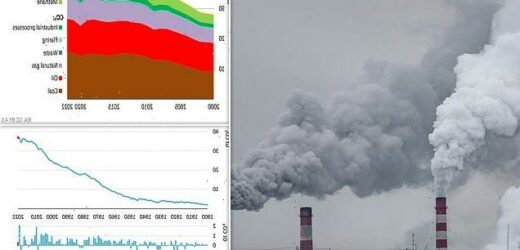Global carbon dioxide emissions rose by 0.9% in 2022 to 36.8 BILLION tonnes – their highest level on record, report reveals
- Globally, more CO2 was emitted in 2022 than any year on record dating to 1900
- This was largely driven by the burning of fossil fuel coal instead of renewables
- Communities switched back to coal during the energy crisis triggered by Russia
Global carbon dioxide (CO2) emissions last year were higher than in any other year on record dating to 1900, a worrying new report reveals.
In 2022, emissions of the gas increased by 0.9 per cent, or 321 million tonnes, to reach a new high of 36.8 billion tonnes, the International Energy Agency (IEA) says.
This was largely due to many countries switching back to coal during the global energy crisis, although the global growth in emissions was lower than feared.
Coal – which is due to be phased out as a power source in the UK from 2024 – accounts for over a third of the world’s total carbon emissions, the report reveals.
Total emissions from coal grew by 1.6 per cent or 243 million tonnes last year to reach a new all-time high of around 15.5 billion tonnes, it says.
Emissions of the climate-warming gas that were caused by energy production grew 0.9 per cent to reach 36.8 billion tonnes in 2022, the International Energy Agency reported Thursday. The biggest source of CO2 emissions is electricity and heat, through the burning of fossil fuels – coal, oil, gas
In 2022, emissions from coal alone (15.5 billion tonnes) were larger than any other fossil fuel including oil and natural gas
The IEA published its ‘CO2 Emissions in 2022’ report on Thursday, which provides a ‘complete picture’ of energy-related greenhouse gas emissions for last year – not just carbon dioxide, but nitrous oxide and methane too.
UK government approves new coal mine – despite decision to phase-out coal as a power source by 2024 – READ MORE
The UK’s first new deep coal mine in 30 years was approved in December 2022
It uses the latest national stats and data on energy use, economic indicators and weather – and includes emissions from all uses of fossil fuels for energy purposes, including power generation, combustion of non-renewable waste and emissions from industrial processes like cement, iron and steel.
‘The impacts of the energy crisis didn’t result in the major increase in global emissions that was initially feared,’ said IEA executive director Fatih Birol.
‘This is thanks to the outstanding growth of renewables, EVs, heat pumps and energy efficient technologies.
‘Without clean energy, the growth in CO2 emissions would have been nearly three times as high.
‘However, we still see emissions growing from fossil fuels, hindering efforts to meet the world’s climate targets.’
Birol blamed international and national fossil fuel companies, which are making record revenues due to the climate crisis.
The owner of British Gas, for example, announced profits of £3.3 billion for 2022 – surpassing the firm’s previous highest ever yearly profit of £2.7 billion posted in 2012.
‘[Fossil fuel companies] need to take their share of responsibility, in line with their public pledges to meet climate goals,’ Birol said.
‘It’s critical that they review their strategies to make sure they’re aligned with meaningful emissions reductions.’
Graphic shows global CO2 emissions from energy combustion and industrial processes (top) and their annual change (bottom) between 1900 and 2022. Note the drastic drop in 2020 due to the effect of the pandemic. Globally, more CO2 was emitted in 2022 than in any other year on records dating to 1900
CO2 is released when fossil fuels such as oil, coal or natural gas are burned to powers cars, planes, homes and factories.
British Gas owner’s profits soar to £3.3bn as millions suffer with cost-of-living crisis – READ MORE
Results for British Gas owner Centrica surpass the company’s previous profit high of £2.7 billion recorded in 2012
When the gas enters the atmosphere, it traps heat and contributes to the warming of the climate.
According to the IEA report, CO2 emissions increased by 423 million tonnes in 2022 over the year prior, while emissions from industrial processes decreased by 102 million tonnes – bringing the overall increase for last year to 321 million tonnes.
To put that into perspective, the mass of one billion tonnes is equivalent to about 10,000 fully loaded aircraft carriers, according to NASA.
Industrial processes include the manufacturing of cement, iron steel and more, and are usually carried out on a very large scale.
But at 15.5 billion tonnes, emissions from coal alone vastly outweighed emissions from industrial processes – or indeed any other emissions source.
The closest was oil, which emitted 11.2 billion tonnes of CO2 in 2022, followed by natural gas (around seven billion tonnes).
Compared with the year prior, CO2 emissions from natural gas fell by 1.6 per cent, or 118 million tonnes, following continued tightening of supply exacerbated by Russia’s invasion of Ukraine.
Just like coal, both oil and natural gas are fossil fuels.
As well as being used to generate energy for homes, oil is used by the aviation industry, which has rebounded since the travel restrictions of the Covid era.
As global airline traffic increased, CO2 emissions from burning oil grew 2.5 per cent, with about half the surge resulting from the aviation sector, the report reveals.
Pictured, the Grootvlei Power Station, a coal-fired power plant operated by Eskom located in Grootvlei, South Africa. In the UK, there are currently three active coal-fired power stations operating – but they will be either decommissioned or converted to gas power by 2024
Ratcliffe-on-Soar Power Station, one of three active coal-fired power stations in the UK. It is scheduled to close in September 2024
Extreme weather events also intensified last year’s CO2 emissions, the report says, as droughts reduced the amount of water available for hydropower, which increased the need to burn fossil fuels.
The report was described as ‘disconcerting’ by climate scientists, who warn that people around the world must cut emissions dramatically to slow the dire consequences of global warming.
‘Any emissions growth – even one per cent – is a failure,’ said Rob Jackson, a professor of earth system science at Stanford University and chairman of the Global Carbon Project, an international group.
‘We can’t afford growth, we can’t afford stasis – it’s cuts or chaos for the planet.
‘Any year with higher coal emissions is a bad year for our health and for the Earth.’
Though emissions continue to grow at worrying levels, a reversal that would help achieve the climate goals that nations have committed to remains possible.
That’s according to John Sterman, director of the Massachusetts Institute of Technology Sloan Sustainability Initiative.
Nations must subsidise renewables, improve energy efficiency, electrify industry and transportation, set a high price for carbon emissions, reduce deforestation, plant trees and rid the system of coal, Sterman argued.
‘This is a massive, massive undertaking to do all these things, but that’s what’s needed,’ he said.
Graph shows global CO2 emissions by sector by year, according to the report. Power generation continues to drive the most emissions
Last year’s level of emissions, though a record high, was nevertheless lower than experts had expected.
Increased deployment of renewable energy, electric vehicles and heat pumps together helped prevent an additional 550 million tonnes of CO2 emissions.
Strict pandemic measures and weak economic growth in China also curtailed production, helping to limit overall global emissions.
In Europe, electricity generation from wind and solar power exceeded that of gas or nuclear for the first time, the IEA said.
Fossil fuels versus renewable energy sources
Renewable sources:
Solar – light and heat from the sun.
Wind – through wind turbines to turn electric generators
Hydro – captured from falling or fast-running water
Tidal – energy from the rise and fall of sea levels
Geothermal – energy generated and stored in the Earth
Biomass – organic material burnt to release stored energy from the sun
Although nuclear energy is considered clean energy its inclusion in the renewable energy list is a subject of major debate.
Nuclear energy itself is a renewable energy source. But the material used in nuclear power plants – uranium – is a non-renewable.
Fossil fuels
Renewables contrast with the more harmful fossil fuels – oil, coal and gas.
They are considered fossil fuels because they were formed from the fossilised, buried remains of plants and animals that lived millions of years ago.
Because of their origins, fossil fuels have a high carbon content, but when they are burned, they release large amounts of carbon dioxide, a greenhouse gas, into the air.
Source: EDF Energy /Stanford University
Source: Read Full Article










